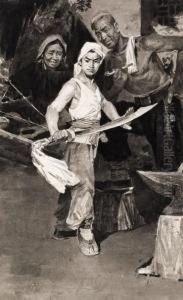Wang Xizhi Paintings
Wang Xizhi was a Chinese calligrapher, writer, and politician who lived during the Jin Dynasty (265–420). He is often referred to as the 'Sage of Calligraphy' (書聖), and is considered by many to be the greatest Chinese calligrapher in history, even though none of his original works are known to have survived. His influence on Chinese calligraphy is profound, with his style serving as a model for subsequent generations of calligraphers.
Wang Xizhi was born into a family of distinguished scholars and officials in Linyi, Shandong. He began learning the art of calligraphy at a very young age, studying the works of earlier masters and quickly developing his own unique style. His talent was evident, and he continued to refine his skills throughout his life, eventually creating a new, more fluid and dynamic form of writing known as the 'running script' (行書).
Throughout his career, Wang Xizhi held various government positions, but his passion always remained with calligraphy. He was also a keen collector of books and art, and he associated with other literati of the time, engaging in artistic and intellectual pursuits. Wang's most famous work, the 'Preface to the Poems Composed at the Orchid Pavilion' (蘭亭集序), also known as 'Lanting Xu,' is a beautifully written piece that describes a gathering of scholars and poets for a springtime festival. Although the original no longer exists, the work survives through numerous traced copies, the most famous being that of the Tang Dynasty calligrapher Feng Chengsu, known as the 'Model Book of the Orchid Pavilion' (蘭亭帖).
Wang Xizhi's legacy is not only found in his own works but also in his influence on future generations. His son, Wang Xianzhi, was also a renowned calligrapher, and together, they are often mentioned as the 'Two Wangs' in the history of Chinese calligraphy. Wang Xizhi's calligraphy was so admired that it was said that the Tang Dynasty Emperor Taizong, a great patron of the arts, had Wang's original 'Lanting Xu' buried with him in his tomb.
The art of Wang Xizhi has been revered for centuries, and his style has been imitated by countless calligraphers. His approach to the written word, emphasizing the expression of emotion and artistic integrity, has made his work a lasting benchmark for calligraphic excellence. Today, Wang Xizhi remains an iconic figure in Chinese cultural history, and his contributions to the art of calligraphy are celebrated with great reverence.

